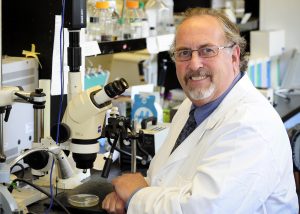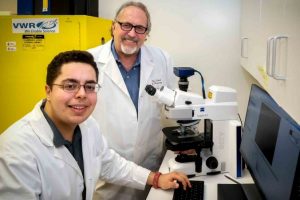Dopamine Receptor Blockade Attenuates Purinergic P2X4 Receptor-Mediated Prepulse Inhibition Deficits and Underlying Molecular Mechanisms
Front Cell Neurosci.
2019
Sensorimotor gating refers to the ability to filter incoming sensory information in a stimulus-laden environment and disruption of this physiological process has been documented in psychiatric disorders characterized by cognitive aberrations. The effectiveness of current pharmacotherapies for treatment of sensorimotor gating deficits in the patient population still remains controversial.
Read More
A newly developed anesthetic based on a unique chemical core
Proceedings of the National Academy of Sciences
Noëlie S. Cayla, Beza A. Dagne, Yun Wu, Yao Lu, Larry Rodriguez, Daryl L. Davies, Eric R. Gross, Boris D. Heifets, M. Frances Davies, M. Bruce MacIver, and Edward J. Bertaccini
Intravenous anesthetic agents are associated with cardiovascular instability and poorly tolerated in patients with cardiovascular disease, trauma, or acute systemic illness. We hypothesized that a new class of intravenous (IV) anesthetic molecules that is highly selective for the slow type of γ-aminobutyric acid type A receptor (GABAAR) could have potent anesthetic efficacy with limited cardiovascular effects. Through in silico screening using our GABAAR model, we identified a class of lead compounds that are N-arylpyrrole derivatives. Electrophysiological analyses using both an in vitro expression system and intact rodent hippocampal brain slice recordings demonstrate a GABAAR-mediated mechanism. In vivo experiments also demonstrate overt anesthetic activity in both tadpoles and rats with a potency slightly greater than that of propofol. Unlike the clinically approved GABAergic anesthetic etomidate, the chemical structure of our N-arylpyrrole derivative is devoid of the chemical moieties producing adrenal suppression. Our class of compounds also shows minimal to no suppression of blood pressure, in marked contrast to the hemodynamic effects of propofol. These compounds are derived from chemical structures not previously associated with anesthesia and demonstrate that selective targeting of GABAAR-slow subtypes may eliminate the hemodynamic side effects associated with conventional IV anesthetics.
Read More
P2X7 Receptor Antagonist A804598 Inhibits Inflammation in Brain and Liver in C57BL/6J Mice Exposed to Chronic Ethanol and High Fat Diet
Journal of Neuroimmune Pharmacology
Daniel FreireRachel E. ReyesAred BaghramDaryl L. DaviesLiana Asatryan
Chronic low-grade neuroinflammation is increasingly implicated in organ damage caused by alcohol abuse. Purinergic P2X7 receptors (P2X7Rs) play an important role in the generation of inflammatory responses during a number of CNS pathologies as evidenced from studies using pharmacological inhibition approach. P2X7Rs antagonism has not been tested during chronic alcohol abuse. In the present study, we tested the potential of P2X7R antagonist A804598 to reduce/abolish alcohol-induced neuroinflammation using chronic intragastric ethanol infusion and high-fat diet (Hybrid) in C57BL/6J mice. We have previously demonstrated an increase in neuroinflammatory response in 8 weeks of Hybrid paradigm. In the present study, we found neuroinflammatory response to 4 weeks of Hybrid exposure. A804598 treatment reversed the changes in microglia and astrocytes, reduced/abolished increases in mRNA levels of number of inflammatory markers, including IL-1β, iNOS, CXCR2, and components of inflammatory signaling pathways, such as TLR2, CASP1, NF-kB1 and CREB1, as well in the protein levels of pro-IL-1β and Nf-kB1. The P2X7R antagonist did not affect the increase in mRNA levels of fraktalkine (CX3CL1) and its receptor CX3CR1, an interaction that plays a neuroprotective role in neuron-glia communication. P2X7R antagonism also resulted in reduction of the inflammatory markers but did not alter steatosis in the liver. Taken together, these findings demonstrate how P2X7R antagonism suppresses inflammatory response in brain and liver but does not alter the neuroprotective response caused by Hybrid exposure. Overall, these findings support an important role of P2X7Rs in inflammation in brain and liver caused by combined chronic alcohol and high-fat diet.
Read More
Si-LENT [Brain] Slice Recordings: a Novel Method for the Ex Vivo Genetic Modification of Neurons
The FASEB Journal
Larry Rodriguez, Chang You, Mark Brodie, and Daryl Davies
Understanding the function of a specific receptor in a cell is key for developing new therapies for diseases. Current early-stage drug development strategies often utilize non-specific or “dirty” drugs/molecules to determine receptor function, as more specific agonists or antagonists may not be available. A second strategy incorporates genetic modifications to determine the role of a receptor in an animal model of disease. This method is time-consuming, expensive, and can produce artifacts that confound or skew results. Furthermore, certain modifications may not produce viable offspring. These issues make developing drugs for neurological conditions more challenging, as the function of a receptor can depend on the brain region where a neuron is located or can require an interaction partner (receptor cross-talk). One way to study neurons is to perform extracellular recordings on mouse or rat brain slices. In these experiments, an electrode is placed near, but not onto or into, a neuron. This electrode, usually filled with a saline solution, measures the number of action potentials over time, a.k.a. the firing rate. Agonists and/or drugs are then perfused on to the neuron, and the effects are reported as a change in the firing rates. Here, we describe a new method: “SiRNA-Loaded Electrodes kNocksdown Target (Si-LENT)” slice electrophysiology. Si-LENT slice is a new method for performing extracellular recordings in brain slice that can knockdown target genes over the course of a recording session. Si-LENT slice incorporates SiRNA into the recording electrode, which is delivered to the cell during the experiment. For the current study, we targeted P2X4 receptors, which we have previously linked to regulation of alcohol consumption. We recorded from dopaminergic (DAergic) neurons located in the ventral tegmental area (VTA) of the mouse brain. DAergic neurons in the VTA of the brain have been shown to be associated with learning, reward, and addiction, but the function of P2X4 receptors in this region is not well understood. We found a significant reduction in receptor activity after two hours of recording, and a sustained reduction for up to two hours thereafter.
Read More
Murine Drinking Models in the Development of Pharmacotherapies for Alcoholism: Drinking in the Dark and Two-bottle Choice
JoVE (Journal of Visualized Experiments)
Nhat Huynh, Natalie M Arabian, Liana Asatryan, Daryl L Davies
Alcohol Use Disorder (AUD) is a major problem with more than an estimated 76 million people worldwide meeting the diagnostic criteria. Current treatments are limited to three FDA-approved medications that are largely ineffective even when combined with psychosocial intervention, as is evident by the high relapse rate. As such, the search for more novel treatments represents an important public health goal. To this end, the following protocol utilizes two simple rodent drinking models to assess the preclinical efficacy of lead anti-alcohol compounds: two-bottle choice (TBC) and drinking in the dark (DID). The former allows mice to voluntary drink in moderation while the latter induces mice to voluntary consume a large amount of alcohol in a short period that mimics binge drinking. The simple and high throughput nature of both of these paradigms allow for rapid screening of pharmacological agents or for identifying strains of mice that exhibit certain voluntary drinking behavior.
Read More
Preclinical evaluation of avermectins as novel therapeutic agents for alcohol use disorders
Psychopharmacology (Berl)
2018
The deleterious effects of alcohol use disorders (AUDs) on human health have been documented worldwide. The enormous socioeconomic burden coupled with lack of efficacious pharmacotherapies underlies the need for improved treatment strategies. At present, there is a growing body of preclinical evidence that demonstrates the potential of avermectins [ivermectin (IVM), selamectin (SEL), abamectin (ABM), and moxidectin (MOX)] in treatment of AUDs.
Read More
Macrophage P2X4 receptors augment bacterial killing and protect against sepsis
JCI Insight
Balázs Csóka, Zoltán H Németh, Ildikó Szabó, Daryl L Davies, Zoltán V Varga, János Pálóczi, Simonetta Falzoni, Francesco Di Virgilio, Rieko Muramatsu, Toshihide Yamashita, Pál Pacher, György Haskó
The macrophage is a major phagocytic cell type, and its impaired function is a primary cause of immune paralysis, organ injury, and death in sepsis. An incomplete understanding of the endogenous molecules that regulate macrophage bactericidal activity is a major barrier for developing effective therapies for sepsis. Using an in vitro killing assay, we report here that the endogenous purine ATP augments the killing of sepsis-causing bacteria by macrophages through P2X4 receptors (P2X4Rs). Using newly developed transgenic mice expressing a bioluminescent ATP probe on the cell surface, we found that extracellular ATP levels increase during sepsis, indicating that ATP may contribute to bacterial killing in vivo. Studies with P2X4R-deficient mice subjected to sepsis confirm the role of extracellular ATP acting on P2X4Rs in killing bacteria and protecting against organ injury and death. Results with adoptive transfer of macrophages, myeloid-specific P2X4R-deficient mice, and P2rx4 tdTomato reporter mice indicate that macrophages are essential for the antibacterial, antiinflammatory, and organ protective effects of P2X4Rs in sepsis. Pharmacological targeting of P2X4Rs with the allosteric activator ivermectin protects against bacterial dissemination and mortality in sepsis. We propose that P2X4Rs represent a promising target for drug development to control bacterial growth in sepsis and other infections.
Read More




